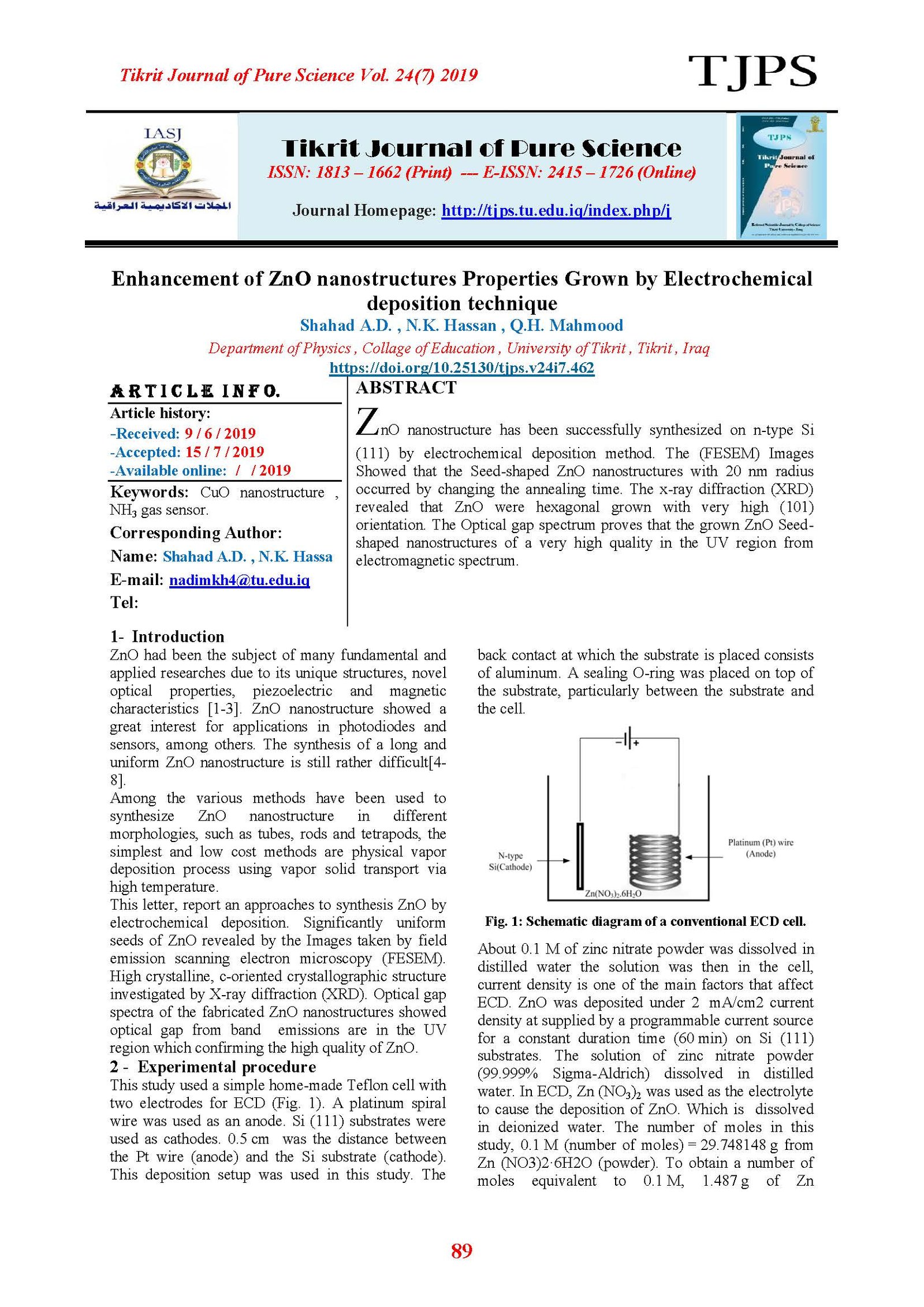Enhancement of ZnO nanostructures Properties Grown by Electrochemical deposition technique
Main Article Content
Abstract
ZnO nanostructure has been successfully synthesized on n-type Si (111) by electrochemical deposition method. The (FESEM) Images Showed that the Seed-shaped ZnO nanostructures with 20 nm radius occurred by changing the annealing time. The x-ray diffraction (XRD) revealed that ZnO were hexagonal grown with very high (101) orientation. The Optical gap spectrum proves that the grown ZnO Seed-shaped nanostructures of a very high quality in the UV region from electromagnetic spectrum.
Article Details

This work is licensed under a Creative Commons Attribution 4.0 International License.
Tikrit Journal of Pure Science is licensed under the Creative Commons Attribution 4.0 International License, which allows users to copy, create extracts, abstracts, and new works from the article, alter and revise the article, and make commercial use of the article (including reuse and/or resale of the article by commercial entities), provided the user gives appropriate credit (with a link to the formal publication through the relevant DOI), provides a link to the license, indicates if changes were made, and the licensor is not represented as endorsing the use made of the work. The authors hold the copyright for their published work on the Tikrit J. Pure Sci. website, while Tikrit J. Pure Sci. is responsible for appreciate citation of their work, which is released under CC-BY-4.0, enabling the unrestricted use, distribution, and reproduction of an article in any medium, provided that the original work is properly cited.
References
[1] Dai, Y., et al., Synthesis and optical properties of tetrapod-like zinc oxide nanorods. Chem.Phys.Lett., 2002. 358 p. 83–86.
[2] Saito, N., et al., Low-Temperature Fabrication of Light-Emitting Zinc Oxide Micropatterns Using Self-Assembled Monolayers. Adv. Mater., 2002. 14(6): p. 418-421.
[3] Ong, H.C., A.X.E. Zhu, and G.T. Du, Dependence of the excitonic transition energies and mosaicity on residual strain in ZnO thin films. Applied Physics Letters, 2002. 80(6): p. 941.
[4] Hassan, J.J., et al., Room temperature hydrogen gas sensor based on ZnO nanorod arrays grown on a SiO2/Si substrate via a microwave-assisted chemical solution method. Journal of Alloys and Compounds, 2013. 546: p. 107-111.
[5] Abdulgafour, H.I., et al., Sensing devices based on ZnO hexagonal tube-like nanostructures grown on p-GaN heterojunction by wet thermal evaporation. Thin Solid Films, 2013.
[6] Hassan, N.K., M.R. Hashim, and N.K. Allam, A facile room temperature electrochemical deposition of pyramidal ZnO nanostructures: Suppressing the green emission. Physica E: Low-dimensional Systems and Nanostructures, 2012. 44(9): p. 1853-1856.
[7] Hassan, N.K., et al., A Catalyst-Free Growth of ZnO Nanowires on Si (100) Substrates: Effect of Substrate Position on Morphological, Structural and Optical Properties. ECS Journal of Solid State Science and Technology, 2012. 1(2): p. P86-P89.
[8] Hassan, N.K., M.R. Hashim, and N.K. Allam, ZnO nano-tetrapod photoanodes for enhanced solar-driven water splitting. Chemical Physics Letters, 2012. 549: p. 62-66.
[9] Guo, L., et al., High responsivity ZnO nanowires based UV detector fabricated by the dielectrophoresis method. Sensors and Actuators B: Chemical, 2012. 166-167: p. 12-16.
[10] Campos, L.C., et al., ZnO UV photodetector with controllable quality factor and photosensitivity. AIP Advances, 2013. 3(2): p. 022104.
[11] Zhang, X.L., K.S. Hui, and K.N. Hui, High photo-responsivity ZnO UV detectors fabricated by RF reactive sputtering. Materials Research Bulletin, 2013. 48(2): p. 305-309.
[12] Wang, Z.L., Splendid One-Dimensional Nanostructures of Zinc Oxide: A New Nanomaterial Family for Nanotechnology. ACS Nano, 2008. 2(10): p. 1987–1992.
[13] Bashkany, Z.A., et al., A Self-Powered Heterojunction Photodetector Based on a PbS Nanostructure Grown on Porous Silicon Substrate. Silicon, 2016. 10(2): p. 403-411.
[14] Kumar, V., et al., Band gap determination in thick films from reflectance measurements. Optical Materials, 1999. 12(1): p. 115-119.
